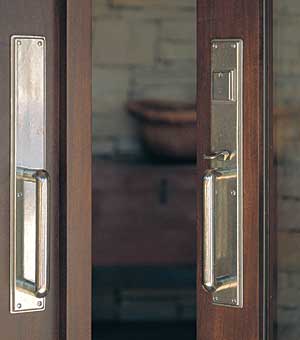Selecting High-End Hardware for Residential, Commercial, and Hospitality Locations
Miscellaneous Functions:
- Corridor−This function allows the inside handles on both sides of the door to be open and functioning. One side has a locking turn piece or push button, such as a mortise lock or locking spring latch. This is typically used to lock an office or room that is not in a public area.
- Classroom−This function allows the inside handle to always be free while the outside handle can either be free or be lockable with a key via a mortise lock or a locking knob or lever. This restricts the locking function to the key holder.
- Store room−The inside handle is always open or free and the exterior handle is always locked. The locking mechanism is keyed from the exterior side.
- Hotel entry−Similar to the storeroom, except that there is an emergency egress deadbolt on the interior, allowing guests the ability to secure their room from the inside.
|
Doors−The size, construction, and proportion of doors are important factors when selecting hardware.
- Stile width−Choosing the width of the escutcheon, the back plate that attaches to the door, depends on the available surface, or stile width, while factoring in the overlap of the stop. These dimensions are critical. The goal is to fit the hardware on the door with an accommodation for ease of operation, thus allowing room to grab the lever or grip without hitting the knuckles. Matt Ostmann, Technical Director at Rocky Mountain Hardware observes, "A common problem that arises often is that the selected stile is too narrow to carry the standard escutcheon. Choosing a narrow stile may severely limit the designer's hardware options."
- Door Size−Typically, the height of the escutcheon is directly proportional to the door height. This is a subjective choice.
- Handing−This is the convention that indicates where the door is hinged and in what direction it swings. The diagram in the Glossary reflects the hardware industry standard. It is important to use the convention as illustrated when handing is specified.
- Backset−This defines the length from the edge of the door to the center of the lock. Standard lengths for tubular or spring latches are 2-3/8 inches and 2-3/4 inches. Standard lengths for mortise locks are 2-1/2 inches and 2-3/4 inches. These can have options for custom backsets but stile and hardware choices may limit the available options.
Design and Style Choices−This encompasses material, finish, and lever, and knob choices, as determined by the aforementioned criteria. Selecting the best hardware material that can function under varied climatic conditions, while maintaining basic design characteristics, has become increasingly challenging. Steel, stainless steel, and aluminum all have their applications, but none can combine resistance, durability, a natural aging process, and a natural appearance as well as bronze.
Bronze has several favorable properties when used for hardware. It is non-ferrous, neither powder-coated nor lacquered, and will not rust. Bronze interacts and ages well, working in coordination with time, touch, and climate. Over time, the material distinctly reflects its surroundings. It ages naturally, but is quite durable and robust. Additionally, bronze can be tempered by various applied patinas, which can speed the aging process to create unique hues to complement any style.










